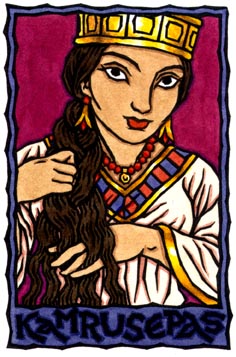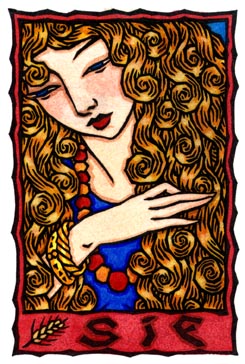
Ah. We would appear to be being Goddess-bothered. This is the third time, now, I have picked Kamrusepas. It is well. She is a very kind Goddess, and Her message is one of healing.
As I have explained on the two previous occasions this card has come up, Kamrusepas is the Hittite Goddess of magic and healing. Her spells and rituals helped bring the petulant harvest-God Telipinu back from his self-imposed exile, and restore fertility and growth to the earth.
My first thought when I picked the card this time (before I went and reread my previous posts on Her) was that She was calling for us to perform spells of self-healing, and that for some reason this was the exact right time to be doing this. Perhaps it is because Spring is coming; even in my neck of the woods the snowdrops are out, and the crocus are budded. And tomorrow is the first of March; it will not be long now.
Looking back on the previous entries on Her I found this quote from Her dating to the first week of the year:
This is what I ask this week. It is your New Year; start with the basics. And this is most basic: how are you kind to yourself? What do you do, on a practical, real, level--I want a list!--to be kind to yourself, to be sweet to yourself? Answer this, deeply, honestly, and with great love. Yes, I am giving you home-work, if you will.
Perhaps, then, She is simply checking in to see if we've done our homework.
I will admit, I don't know how far I have gotten with the assignment myself. It is hard work, learning to be kind to yourself.
I ask Her what She has to tell us this time, and She says:
Keep at this, this kindness and this healing; for kindness and healing are bound up together and cannot be separated. You are doing well, very well, though you may not know it; and I am so sorry that this work is hard. It should not be hard work to learn to be gentle with yourself. Yes, this Work is ongoing; and I am here to remind you to keep at it and have faith, for it makes the world of difference.
When I ask Her how do we do this? She says:
Love yourself. Heal yourself. Be kind to yourself. Now. Right now. Stop what you are doing, stop your spiraling thoughts of unworth; dig in, and love yourself. It all comes down to that. Where to start, with love and healing? It is so sad that you do not know; but that makes it all the more urgent, doesn't it? Start with compassion for yourself, always. Look over your past deeds and forgive yourself. Forgive yourself your mistakes and your humanity; then, love yourself for your mistakes and your humanity. This week? You want another assignment?
Look back in your past, all of you, not just Thalia here I'm talking to, all of you, and find a deed that you are not proud of. If you are feeling afraid of digging back into it, that is all right; you can choose a small deed, a little regret, if that is all you can handle. And allow yourself to choose something small if you like; that right there is a way to be kind to yourself. Then from that most compassionate, gentle, kind part of yourself, address that maker-of-mistakes part of you as you would a frightened child, with deep love, understanding, and forgiveness. Do not judge it by what you know now; appreciate and thank that part of you and the mistakes you made then as contributing to your wisdom today.
I will think about this, and see what I can do. How about you? Do you have other suggestions on healing ourselves through kindness?
Also, any thoughts on why Kamrusepas is showing up so much?


















